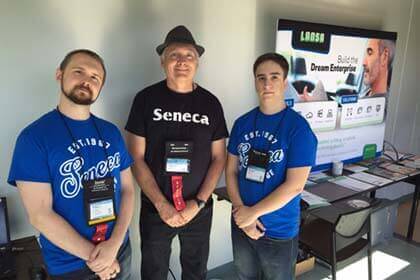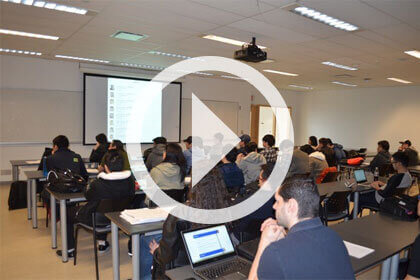SENECA ICT STUDENTS IN TUNE WITH THE REAL WORLD
Seneca College, located in Toronto, Canada, is one of the largest colleges in Canada, offering nearly 300 programs at baccalaureate, diploma, certificate and graduate levels. Seneca provides education to over 70,000 part-time and 27,000 full-time students from its 10 campuses in the greater Toronto area.
Seneca’s School of ICT (Information and Communication Technology) has built up a reputation of graduating a high caliber of students that are career ready. One of the School’s major differentiators is its strong curriculum with a choice of labs for practical hands-on experience. Professional options (electives) include application development using a variety of tools on various platforms. A recent popular addition to the electives is Mobile App Development for IBM i.
- Being in Tune with the Real World
- Mobile for IBM i in School
- Presenting at User Group Meetings
- About Seneca College
Being in Tune with the Real World

Teaching staff at Seneca’s School of ICT continuously seek to improve the work readiness of their students. To do so they are in regular dialog with potential employers and actively seek feedback from current and graduated students.
Russell Pangborn is a Professor at Seneca’s School of ICT and also a board member of the Toronto Users Group for IBM Power Systems (TUG), a professional forum for the presentation and exchange of ideas that pertain to IBM i users. Russ was instrumental in adding Mobile App Development for IBM i as a professional option to Seneca’s Computer Programming & Analysis major.
Russ explains, “We have a faculty that is passionate about technology and we occasionally have epic battles in our departmental meetings over what we can squeeze into a limited size curriculum. Seeing the huge impact that AS/400 technology (now called IBM i) was having in the industry in the 1990’s, I took up the cause of getting it into our curriculum. Over the last 25 years IBM i related core subjects and electives have included RPG, C++ and Java programming, CLLE, advanced DB2 and Lotus Domino.”
“We were an early adopter of RDi (Rational Developer for IBM i) and our graduates often used to tell me that they were the first ones at their company who were familiar with it and that they had to teach their colleagues about it.”
“Obviously the excitement about the RPG development language has long gone. But that should not result in the view that there is no business value in existing RPG applications. Neither should it result in the perception that the platform on which those applications run is old tech.”
“I aim to teach my students that they should analyze a company’s existing application portfolio before making any judgements. They need to learn how to assess which applications are ‘okay-as-is’, which ones are candidates for modernization and extension, and which ones are beyond salvage and need to be re-built or bought.”
Needless to say that Russ always keeps an eye out for tools that can be used to extend or modernize existing IBM i applications, such as for mobile access, Web enablement or web service integration. In that context, Russ immediately recognized the potential of LANSA’s LongRange, a mobile app development tool, when he heard about it a TUG meeting.
You need to analyze a company’s existing application portfolio before making any judgements.
Mobile for IBM i in School
Using the LongRange online tutorials and a free trial license, Russ and one of his RPG students evaluated the product. They concluded it would be a very suitable subject for an elective and together they convinced the department to put it up as a professional option for the upcoming semester. It was named MAP525 (Mobile App Development for IBM i).
Russ continues, “LongRange perfectly demonstrates to students how they can combine the soundness of a widely used and mature system with the new and exciting possibilities provided by mobile technology.”
Students can choose to get a brief introduction to RPGLE application development in the second semester and then use that as a vehicle to develop sophisticated mobile apps with LongRange and RPG, without having to dive into objective C or Java. Forty percent of a students’ grade is based on a final project, rather than a final exam.
Several of Russ’ students were able to produce impressive mobile apps using LongRange. For example, one of his students created an app as an extension to a payroll system. The app allows users to add and change contact details, location/address maps and employee photos, and integrates with the email and phone facilities on the mobile device.
LongRange perfectly demonstrates how to combine a sound and mature system with new mobile technology.
Presenting at User Group Meetings

Each semester a student whom demonstrates exceptional performance in the classroom and understanding of the IBM i platform is selected for the TUG award. Russ writes an article about each of those students. The award is presented at the TUG Conference and one of the recipients received a job interview on the spot.
Russ also provides his students with opportunities to present their mobile projects at TUG meetings and at the annual TEC conference. Students gain from the experience of speaking in public and communicating with seasoned IT professionals. The TEC2015 sessions about mobile apps for IBM i, presented by Seneca students, were well attended and received positive feedback from industry people.
“Using LongRange mobile app development provides a perfect example to my students of how they can capitalize on existing business functionality by extending existing code with new technology. Having an understanding of mature development languages like RPG, as well as having an understanding of new development and integration technologies, makes my students well prepared for the real world and popular with potential employers,” concludes Russ.
Having an understanding of mature development languages as well as of new technologies, makes my students well prepared for the real world.
About Seneca College
![]()
- One of Canada’s leading postsecondary institutions, Seneca offers a comprehensive range of programs across all disciplines to nearly 100,000 full- and part-time students in campuses across the Greater Toronto Area. Seneca’s graduate certificates, degrees, diplomas and certificates attract more than 5,000 students from 120 countries around the world and students from across Canada. With an emphasis on work-integrated learning, interdisciplinary study and flexible learning opportunities, Seneca is the pre-eminent institution in Ontario, Canada for transfer options to and from universities and colleges.
- For more information visit: www.senecacollege.ca
Related Links
